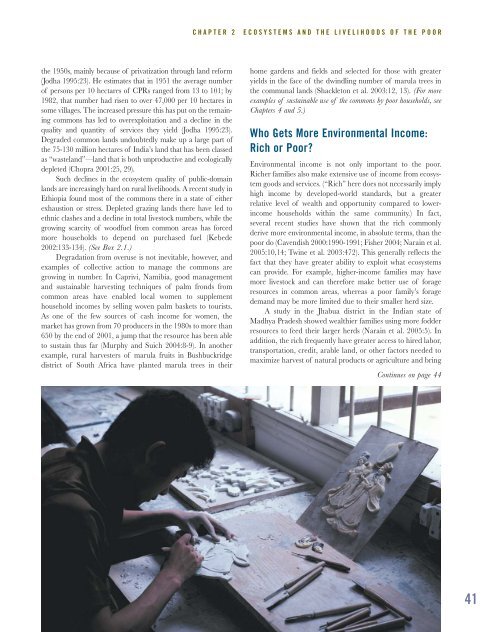jp8589 WRI.qxd - World Resources Institute
jp8589 WRI.qxd - World Resources Institute
jp8589 WRI.qxd - World Resources Institute
Create successful ePaper yourself
Turn your PDF publications into a flip-book with our unique Google optimized e-Paper software.
CHAPTER 2<br />
ECOSYSTEMS AND THE LIVELIHOODS OF THE POOR<br />
the 1950s, mainly because of privatization through land reform<br />
(Jodha 1995:23). He estimates that in 1951 the average number<br />
of persons per 10 hectares of CPRs ranged from 13 to 101; by<br />
1982, that number had risen to over 47,000 per 10 hectares in<br />
some villages. The increased pressure this has put on the remaining<br />
commons has led to overexploitation and a decline in the<br />
quality and quantity of services they yield (Jodha 1995:23).<br />
Degraded common lands undoubtedly make up a large part of<br />
the 75-130 million hectares of India’s land that has been classed<br />
as “wasteland”—land that is both unproductive and ecologically<br />
depleted (Chopra 2001:25, 29).<br />
Such declines in the ecosystem quality of public-domain<br />
lands are increasingly hard on rural livelihoods. A recent study in<br />
Ethiopia found most of the commons there in a state of either<br />
exhaustion or stress. Depleted grazing lands there have led to<br />
ethnic clashes and a decline in total livestock numbers, while the<br />
growing scarcity of woodfuel from common areas has forced<br />
more households to depend on purchased fuel (Kebede<br />
2002:133-134). (See Box 2.1.)<br />
Degradation from overuse is not inevitable, however, and<br />
examples of collective action to manage the commons are<br />
growing in number. In Caprivi, Namibia, good management<br />
and sustainable harvesting techniques of palm fronds from<br />
common areas have enabled local women to supplement<br />
household incomes by selling woven palm baskets to tourists.<br />
As one of the few sources of cash income for women, the<br />
market has grown from 70 producers in the 1980s to more than<br />
650 by the end of 2001, a jump that the resource has been able<br />
to sustain thus far (Murphy and Suich 2004:8-9). In another<br />
example, rural harvesters of marula fruits in Bushbuckridge<br />
district of South Africa have planted marula trees in their<br />
home gardens and fields and selected for those with greater<br />
yields in the face of the dwindling number of marula trees in<br />
the communal lands (Shackleton et al. 2003:12, 13). (For more<br />
examples of sustainable use of the commons by poor households, see<br />
Chapters 4 and 5.)<br />
Who Gets More Environmental Income:<br />
Rich or Poor?<br />
Environmental income is not only important to the poor.<br />
Richer families also make extensive use of income from ecosystem<br />
goods and services. (“Rich” here does not necessarily imply<br />
high income by developed-world standards, but a greater<br />
relative level of wealth and opportunity compared to lowerincome<br />
households within the same community.) In fact,<br />
several recent studies have shown that the rich commonly<br />
derive more environmental income, in absolute terms, than the<br />
poor do (Cavendish 2000:1990-1991; Fisher 2004; Narain et al.<br />
2005:10,14; Twine et al. 2003:472). This generally reflects the<br />
fact that they have greater ability to exploit what ecosystems<br />
can provide. For example, higher-income families may have<br />
more livestock and can therefore make better use of forage<br />
resources in common areas, whereas a poor family’s forage<br />
demand may be more limited due to their smaller herd size.<br />
A study in the Jhabua district in the Indian state of<br />
Madhya Pradesh showed wealthier families using more fodder<br />
resources to feed their larger herds (Narain et al. 2005:5). In<br />
addition, the rich frequently have greater access to hired labor,<br />
transportation, credit, arable land, or other factors needed to<br />
maximize harvest of natural products or agriculture and bring<br />
Continues on page 44<br />
41

















